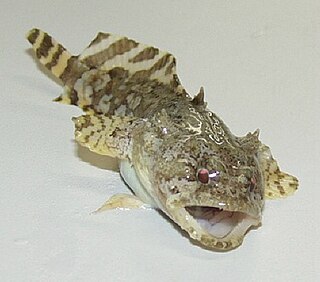
Batrachoididae is the only family in the ray-finned fish order Batrachoidiformes. Members of this family are usually called toadfish, or "frogfish": both the English common name and scientific name refer to their toad-like appearance.
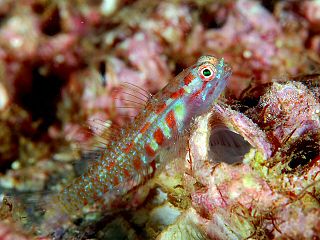
Eviota is a genus of fish in the family Gobiidae, commonly as dwarfgobies found in the Indo-Pacific region, where it is distributed from Japan to Australia and from Africa to Pitcairn Island. Species are mainly associated with coral reefs. Many of these fish are short-lived, with life cycles as brief as 3.5 weeks in the tropics. Some species are hermaphrodites and some representatives live symbiotically among the tentacles of the mushroom coral.

Batrachoides is a genus of toadfishes.
The whitelined toadfish is a species of fish in the family Batrachoididae. It is endemic to Belize. The specific name honours David W. Greenfield and Teresa Arambula Greenfield, who when they collected type specimen thought that it might belong to an undescribed species and so sent it to Bruce Baden Collette to be described.
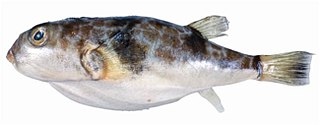
Reicheltia halsteadi, Halstead's toadfish, is a species of pufferfish endemic to Australia. This species grows to a length of 16 centimetres (6.3 in) TL. This species is the only known member of its genus.
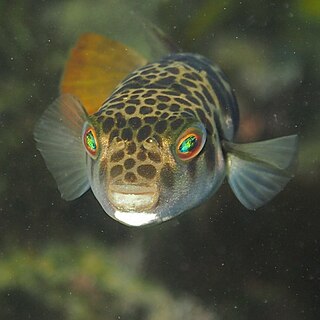
The smooth toadfish is a species of fish in the pufferfish family Tetraodontidae. It is native to shallow coastal and estuarine waters of southeastern Australia, where it is widespread and abundant. French naturalist Christophe-Paulin de La Poix de Fréminville described the species in 1813, though early records confused it with its close relative, the common toadfish. The two are the only members of the genus Tetractenos after going through several taxonomic changes since discovery.

Allenbatrachus is a genus of toadfishes found in the Indian and western Pacific Oceans. The generic name honours the Humboldt State University ichthyologist George Allen (1923-2011), who introduced David Greenfield, who coined the name, to ichthyology.

The banded toadfish is a species of toadfish found along the Pacific coast of South America where it is found in Chile, Ecuador and Peru. This species grows to a length of 28 centimetres (11 in) TL. It is the only member of the monotypic genus Aphos. Unlike the other genus, Porichthys in this subfamily the banded toadfish lacks photophores.
Austrobatrachus is a genus of toadfishes found in the Atlantic and Indian Oceans off the coast of South Africa.
Barchatus cirrhosus is a species of toadfish native to the western Indian Ocean and the Red Sea. This species grows to a length of 35 cm (14 in). It is one of the species of toadfishes known to have venomous spines.
Chatrabus is a genus of toadfishes native to the Atlantic coast of southern Africa.

Colletteichthys is a genus of toadfishes found in the western Indian Ocean. The generic name is a compound of the surname Collette, in honour of the American ichthyologist Bruce Baden Collette to recognise his contribution to the study of toadfish, and the Greek ichthys meaning "fish".

Daector is a genus of toadfishes, with three species found along the Pacific Coast of Central America and two species, D. gerringi and D. quadrizonatus, are found in South American rivers.

Opsanus is a genus of toadfishes found in the western Atlantic Ocean. It currently has six recognised species, with the latest one described in 2005.
Perulibatrachus is a genus of toadfishes known from the Indian and Atlantic Oceans.

Zoramia is a genus of cardinalfishes native to the Indian and Pacific Ocean.
Psilotris is a genus of gobies native to the western Atlantic Ocean.
Porichthyinae is a subfamily of toadfish in the family Batrachoididae. They are found in the eastern Pacific Ocean and western Atlantic from Canada to Argentina. The species of this subfamily have no venom glands or subopercular spines, they have canine like teeth and two solid spines in the dorsal fin.
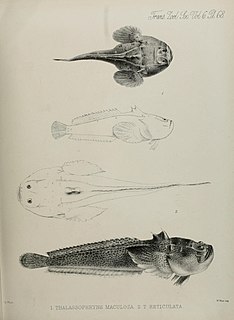
Thalassophryninae is a subfamily of toadfish in the family Batrachoididae. The species in the subfamily are characterised by the possession of two dorsal fin spines, a lack of subopercular spines, with the dorsal and opercular spines being hollow and have venom glands at their base. They do not have canine teeth.

Thalassophryne maculosa, the Cano toadfish, is a species of toadfish which is common along the Caribbean coasts of South America from Colombia to Trinidad and Venezuela. It occurs on the sandy bottoms of reef flats, lagoons, and seaward edges of reefs where it sits partially buried in the substrate. It is a venomous species with the venom being delivered through spines and wounds from the spines have been known to cause severe symptoms of pain and illness that may persist for up to a week. A study of the holotype of Batrachus uranoscopus, said to be a freshwater toadfish from Madagascar, in the Muséum national d’Histoire Naturelle in Paris found that it was most probably a misslabelled specimen of Thalassophryne maculosa and that subsequent records of Batrachus uranoscopus were attributable to Allenbatrachus meridionalis, a species found in Madagascar. T. maculosa is the type species of the genus Thalassophryne, the generic name translates from Greek as "sea toad" while the specific name is Latin for "spotted".











